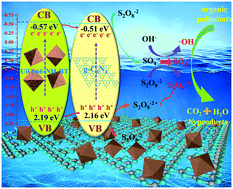In situ growth of benzothiadiazole functionalized UiO-66-NH2 on carboxyl modified g-C3N4 for enhanced photocatalytic degradation of sulfamethoxazole under visible light†
Abstract
Developing low-cost and high-performance photocatalysts is significant for environmental protection but still remains challenging. Herein, a list of UiO-66-NH-BT@g-C3N4 composites decorated with electron deficient units were first constructed through a simple step-by-step in situ growth strategy, and the obtained hybrid photocatalysts (denoted as UiO-66-NH-BT@g-C3N4) were then employed as an efficient mediator to activate peroxydisulfate in order to degrade typical antibiotics. Obviously, embedding carboxyl groups on the surface of g-C3N4 would provide a good environment for the growth of UiO-66-NH-BT, while the introduction of benzothiadiazole could effectively facilitate the separation and transfer of charge carriers. Furthermore, the formation of an n–n heterojunction interface between g-C3N4 and UiO-66-NH-BT could further promote charge transfer. As expected, the UiO-66-NH-BT@g-C3N4-2 hybrid photocatalysts showed great photocatalytic activity in SMX degradation, with the highest removal efficiency of 97.6%. A possible photocatalytic mechanism was also proposed. More importantly, the UiO-66-NH-BT@g-C3N4-2 composite with excellent stability can efficiently remove other antibiotics (e.g., TC, OFX, DFC and IBP) in a very short period of time. In short, the current work has not only developed a promising system (namely the UiO-66-NH-BT@g-C3N4-2/PS/solar system) for the removal of contaminants, but has also shared a novel strategy to synthesize a highly-efficient photocatalyst.



 Please wait while we load your content...
Please wait while we load your content...